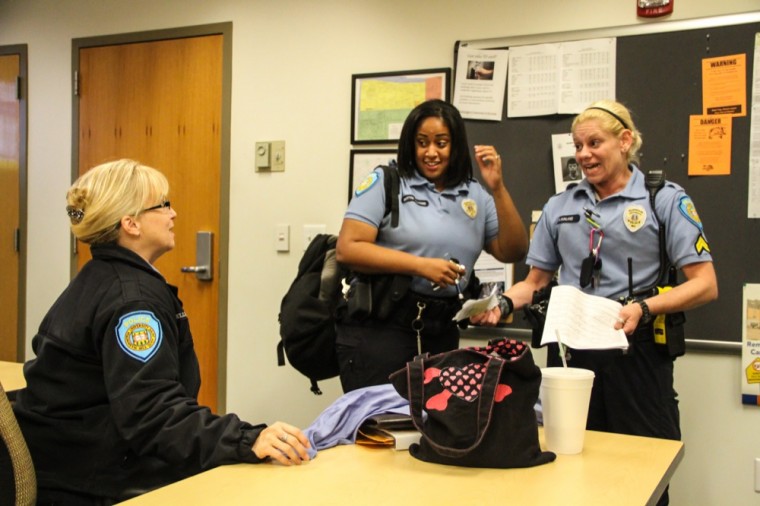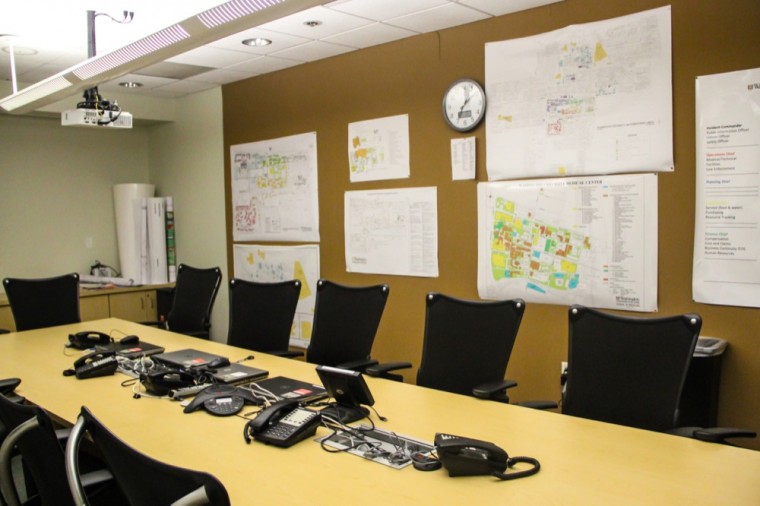News
WUPD, WU emergency officials detail plan in case of active shooting situation
In the wake of shootings on college campuses, students nationwide are left with questions about their universities’ precautionary measures. While Washington University has several components to its safety plan, including trainings and communication, these plans are not communicated to students with regularity.
 Stephen Huber | Student Life
Stephen Huber | Student Life Washington University Police Department officers talk about focus areas at a nightly meeting in September 2014. In wake of recent school shootings, WUPD and the Emergency Response Team have detailed their preparation plans on campus.
Washington University Police Department, the Emergency Management Office and various campus departments have created a plan to keep students and faculty safe on campus through a variety of emergencies.
Despite this plan and training for officers and administrators, however, students are left in the dark in terms of how to react if an active shooting were to occur. WUPD officials say that holding a drill to practice response to an active shooter would be too complicated.
In the case of an active shooting, dispatches would be sent to off-campus police units throughout the St. Louis area. WUPD trains in shooter response with officers from numerous local police departments in order to practice interdepartmental cooperation.
The WUSTLAlert System is activated during all campus emergencies. In the event of an active shooter, text messages, desktop pop-ups, e-mail alerts and in-building audio messages would be deployed in order to warn the campus community and its visitors of the situation at hand.
Emergency Management Program Director Mark Bagby said that the Run, Hide, Fight approach, which prioritizes escaping from the shooter, is the most widely used response plan and the one most likely to succeed.
“Run. If you can get out of the area so you’re not a victim anymore, that’s your best option, but if you can’t, then hide or fight. If you can find a room where there’s a lock on the door, you can barricade the door, shut off the lights, close the curtains, hide under the table, make yourself invisible…If you’re toe to toe with the attacker, fight for your life,” Bagby said.
If fighting the shooter is the only available option, anything can be a defense weapon. Chairs, textbooks, car keys and any number of everyday objects can be lifesaving, according to Bagby.
 Stephen Huber | Student Life
Stephen Huber | Student Life The WUPD building holds a emergency situation room for catastrophes ranging from natural disasters to potential active shooter situations. Maps of University properties and surrounding areas covered the wall for officers and administrative figures that may need to use the room.
While Washington University conducts both fire and tornado drills, no such drills exist to teach students how to safely evacuate the site of a shooting or barricade themselves into a safe space.
Bagby indicated that the reason for this discrepancy in campus drills is that fire and tornado drills are required for compliance purposes, but no such requirements are in place regarding shooting safety drills. WUPD’s Lieutenant Mark Glenn believes that these drills would be too complicated to organize and too confusing for potential campus visitors.
Training comes solely in the form of unpublicized classes that primarily target university employees and are categorized on the University Emergency webpage as Workplace Violence/Active Shooter Training training courses.
Glenn said that all WUPD officers are trained in active shooter response.
“Our first response is to get into the building,” Glenn said. “We’re going in, and we’re going to stop the destructive actions from getting any worse.”
Glenn believes that college campuses are a popular target for shooters because they provide “a target of opportunity” due to the availability and density of people.
Bagby said many campus shootings would have been preventable if warning signs were taken seriously and proper steps were taken to confront and shut down the shooter. Bagby said that recognizing and reporting these cries for help could save lives.
Glenn said various people observe warning signs from potential shooters, but believe their observations to be isolated incidents unworthy of concern. It is important to report all observed suspicious activities before they result in deadly actions.
“It goes down to communication,” Glenn said.
